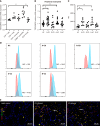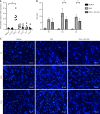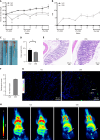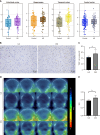Translocator protein facilitates neutrophil-mediated mucosal inflammation in inflammatory bowel diseases
- PMID: 40741102
- PMCID: PMC12305146
- DOI: 10.3748/wjg.v31.i27.109239
Translocator protein facilitates neutrophil-mediated mucosal inflammation in inflammatory bowel diseases
Abstract
Background: Inflammatory bowel diseases (IBD), including ulcerative colitis (UC) and Crohn's disease (CD), are chronic gastrointestinal disorders with an increasing global prevalence and significant healthcare impact. The exact etiology of this condition remains unclear. Neutrophils play a critical role in IBD pathogenesis. Translocator protein (TSPO), a mitochondrial protein linked to immune responses, has demonstrated potential as an inflammatory marker. However, its role in IBD remains underexplored.
Aim: To investigate the role of TSPO in IBD pathogenesis, particularly in neutrophils.
Methods: Bioinformatics analyses of Gene Expression Omnibus datasets (GE75214, GSE94648, GSE156776) assessed TSPO expression in IBD patients. TSPO expression was evaluated in human IBD samples, neutrophiles and a chronic colitis mouse model. Neutrophil function was examined in 18 samples using reactive oxygen species (ROS) production and neutrophil extracellular trap (NET) formation assays. Positron emission tomography-computed tomography (PET-CT) imaging and histology from 12 mice revealed TSPO expression in colitis. PET-CT and immunofluorescence staining assessed TSPO expression in brain under neuroinflammation condition.
Results: Bioinformatics analysis revealed elevated TSPO expression in the intestinal mucosa and peripheral blood of patients with IBD, especially in neutrophils. This was confirmed by quantitative real-time polymerase chain reaction and immunohistochemical staining, which showed a significant upregulation of TSPO in active IBD. Neutrophils from patients with UC and CD exhibited higher TSPO expression, which correlated with increased ROS production and NET formation. In a mouse model of dextran sodium sulfate-induced chronic colitis, TSPO was upregulated in the colonic neutrophils and brain tissues, indicating its systemic involvement. PET-CT imaging showed enhanced TSPO uptake in the inflamed colon and brain regions, particularly in the microglia, highlighting neuroinflammation.
Conclusion: TSPO is significantly upregulated in neutrophils in IBD and contributes to intestinal inflammation. Its elevated expression in gut highlights its potential as a promising therapeutic target for IBD.
Keywords: Crohn's disease; Expression; Gut-brain axis; Inflammatory bowel disease; Intestinal inflammation; Neuroinflammation; Neutrophil; Positron emission tomography-computed tomography; Translocator protein; Ulcerative colitis.
©The Author(s) 2025. Published by Baishideng Publishing Group Inc. All rights reserved.
Conflict of interest statement
Conflict-of-interest statement: All the authors report no relevant conflicts of interest for this article.
Figures







Similar articles
-
Granzyme B PET Imaging for Assessment of Disease Activity in Inflammatory Bowel Disease.J Nucl Med. 2024 Jul 1;65(7):1137-1143. doi: 10.2967/jnumed.123.267344. J Nucl Med. 2024. PMID: 38754959 Free PMC article.
-
Neutrophils and NETs in Pathophysiology and Treatment of Inflammatory Bowel Disease.Int J Mol Sci. 2025 Jul 23;26(15):7098. doi: 10.3390/ijms26157098. Int J Mol Sci. 2025. PMID: 40806230 Free PMC article. Review.
-
[Characteristics and clinical significance of neutrophil extracellular traps in children with inflammatory bowel disease].Zhonghua Er Ke Za Zhi. 2025 Jul 2;63(7):759-764. doi: 10.3760/cma.j.cn112140-20241217-00922. Zhonghua Er Ke Za Zhi. 2025. PMID: 40518155 Chinese.
-
Resolvin D2 and Its Effects on the Intestinal Mucosa of Crohn's Disease Patients: A Promising Immune Modulation Therapeutic Target.Int J Mol Sci. 2025 Jun 23;26(13):6003. doi: 10.3390/ijms26136003. Int J Mol Sci. 2025. PMID: 40649782 Free PMC article.
-
Circulating and intestinal regulatory T cells in inflammatory bowel disease: A systemic review and meta-analysis.Int Rev Immunol. 2024;43(2):83-94. doi: 10.1080/08830185.2023.2249525. Epub 2023 Aug 24. Int Rev Immunol. 2024. PMID: 37615427
References
-
- Kaplan GG. The global burden of IBD: from 2015 to 2025. Nat Rev Gastroenterol Hepatol. 2015;12:720–727. - PubMed
-
- Kobayashi T, Siegmund B, Le Berre C, Wei SC, Ferrante M, Shen B, Bernstein CN, Danese S, Peyrin-Biroulet L, Hibi T. Ulcerative colitis. Nat Rev Dis Primers. 2020;6:74. - PubMed
-
- Ballesteros I, Rubio-Ponce A, Genua M, Lusito E, Kwok I, Fernández-Calvo G, Khoyratty TE, van Grinsven E, González-Hernández S, Nicolás-Ávila JÁ, Vicanolo T, Maccataio A, Benguría A, Li JL, Adrover JM, Aroca-Crevillen A, Quintana JA, Martín-Salamanca S, Mayo F, Ascher S, Barbiera G, Soehnlein O, Gunzer M, Ginhoux F, Sánchez-Cabo F, Nistal-Villán E, Schulz C, Dopazo A, Reinhardt C, Udalova IA, Ng LG, Ostuni R, Hidalgo A. Co-option of Neutrophil Fates by Tissue Environments. Cell. 2020;183:1282–1297.e18. - PubMed
-
- Gao H, Peng K, Shi Y, Zhu S, Sun R, Xu C, Liu P, Pang Z, Zhu L, Chen W, Feng B, Wu H, Zhou G, Li M, Li J, Ding B, Liu Z. Development and validation of a novel criterion of histologic healing in ulcerative colitis defined by inflammatory cell enumeration in lamina propria mucosa: A multicenter retrospective cohort in China. Chin Med J (Engl) 2024;137:1316–1323. - PMC - PubMed
MeSH terms
Substances
LinkOut - more resources
Full Text Sources
Medical

